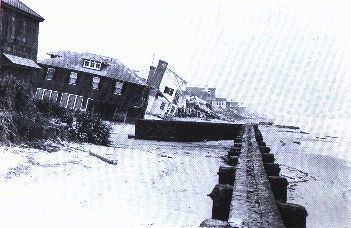Dissipated March 9, 1962 | Formed March 5, 1962 Maximum snowfall or ice accretion 23.6 inches (59.9 cm) | |
 | ||
Areas affected Mid-Atlantic and Southern New England coast | ||
The Ash Wednesday Storm of 1962 occurred on March 6–8, 1962 along the mid-Atlantic coast of the United States. Also known as the Great March Storm of 1962, it was considered by the U.S. Geological Survey to be one of the most destructive storms ever to affect the mid-Atlantic states. Classified as a level 5 or Extreme Nor'easter by the Dolan-Davis scale for classification of Atlantic Nor'easters it was one of the ten worst storms in the United States in the 20th century. It lingered through five high tides over a three-day period, killing 40 people, injuring over 1,000, and causing hundreds of millions in property damage in six states. The storm also deposited significant snowfall over the Southeast, with a regional snowfall index of 12.663.
Contents
Combination of atmospheric conditions
The massive storm was caused by an unusual combination of three pressure areas, combined with the Spring equinox causing exceptionally high tides. The storm stalled in the mid-Atlantic for almost three days, pounding coastal areas with continuous rain, high winds, and tidal surges, and dumping large quantities of snow inland for several hundred miles.
Coastal impact
Homes, hotels, motels, and resort businesses were destroyed along North Carolina's Outer Banks from Cape Hatteras, Nags Head, and Kill Devil Hills north to Virginia Beach, where the waves broke the concrete boardwalk and sea wall. Even some cities further inland such as Norfolk and Hampton in Hampton Roads were inundated with punishing winds and high water. Construction work underway on the new Chesapeake Bay Bridge-Tunnel was dealt a severe blow, and a major piece of custom-built construction equipment called "The Big D" was destroyed.
At the Town of Chincoteague on Virginia's Eastern Shore near the border with Maryland, six feet (2 m) of water covered parts of Main Street, and most of the island was flooded to various depths. On adjacent Assateague Island, the Chincoteague Fire Company lost a portion of its herd of wild Chincoteague Ponies. Misty, the local pony made famous by Marguerite Henry's award-winning children's book Misty of Chincoteague and the 1961 movie Misty, survived by being brought inside a house. Also along the Delmarva Peninsula, at Wallops Island, a million dollars in damage was done to NASA's Wallops Flight Facility.
Further north, 60 mph (96 km/h) winds and 7.6 m (25 ft) waves struck Ocean City, Maryland and the resort developments beginning on Assateague Island were destroyed. Waves more than 12 m (40 ft) high occurred at Rehoboth Beach, Delaware destroying the boardwalk and beach front homes. Sand dunes were flattened along the entire length of Delaware’s ocean coastline. In New Jersey, the storm ripped away part of the Steel Pier in Atlantic City. Avalon, New Jersey lost 6 blocks. Long Beach Island was cut through in several places. The decommissioned destroyer Monssen was washed ashore near Holgate. In New Jersey alone, an estimated 45,000 homes were destroyed or greatly damaged. In New York, on Long Island, communities such as Fire Island were decimated; 100 homes there were destroyed. Wave heights reached 12 m (40 ft) by the shore of New York City. Extensive damage to trees and structures and beach erosion was also reported along the southern New England coast, particularly along coastal Rhode Island, and in New London and Fairfield Counties in Connecticut, although less severe beach erosion was reported in Massachusetts, New Hampshire, and Maine.
Inland weather
The weather front off the coast drove snow upon inland areas. Snow fell as far south as Alabama, and temperatures plunged to around 0°C (32°F) across Florida. North Carolina experienced blizzard conditions. The Shenandoah Valley received nearly 60 cm (2 ft) of snow. In Shenandoah National Park in the Blue Ridge Mountains, 1 m (39 in) of snow were recorded at Big Meadows. The storm tracked far enough south that New England avoided major snowfall, with immediate coastal areas of Connecticut, Rhode Island, and Massachusetts receiving 2–4 inches of snow, and with little to no accumulation away from the immediate shoreline areas.
Aftermath
The Ash Wednesday Storm of 1962 killed 40 people and injured more than 1,000. The coastal areas from North Carolina to New York were battered and changed forever by the wind, waves, and record high tides. Thousands of homes and businesses were flooded and many destroyed. Property damage was caused in six states valued in the hundreds of millions of dollars.
Its impact was so powerful that the U.S. Weather Bureau took the extraordinary step of giving it a name: "The Great Atlantic Storm." It is also known as "Five High Storm" because it lingered off the Atlantic Coast of the northeast United States over a period of five high tides. However, because the heaviest damages occurred in most areas on Wednesday, March 7, which was the Christian holiday of Ash Wednesday, the first day of Lent that year, it has become most popularly well known as the "Ash Wednesday Storm of 1962."
Perhaps a fitting memorial to what was lost in the storm is Assateague Island National Seashore, a unit of the National Park Service. In the 1950s, some 5,000 private lots comprising what is now National Park Service land were zoned and sold for resort development. The Ash Wednesday Storm halted the plans for development, as it destroyed the few existing structures on the island and ripped roads apart. Instead, in 1965, Assateague Island became a National Seashore.
Popular culture
Shortly after the storm subsided, Misty, the famous horse from Chincoteague who spent the storm in the family's kitchen (her barn was flooded) gave birth to a foal. The family named her "Stormy", laying the basis for another book in Marguerite Henry's award-winning Misty of Chincoteague series. The new book was named Stormy, Misty's Foal.
